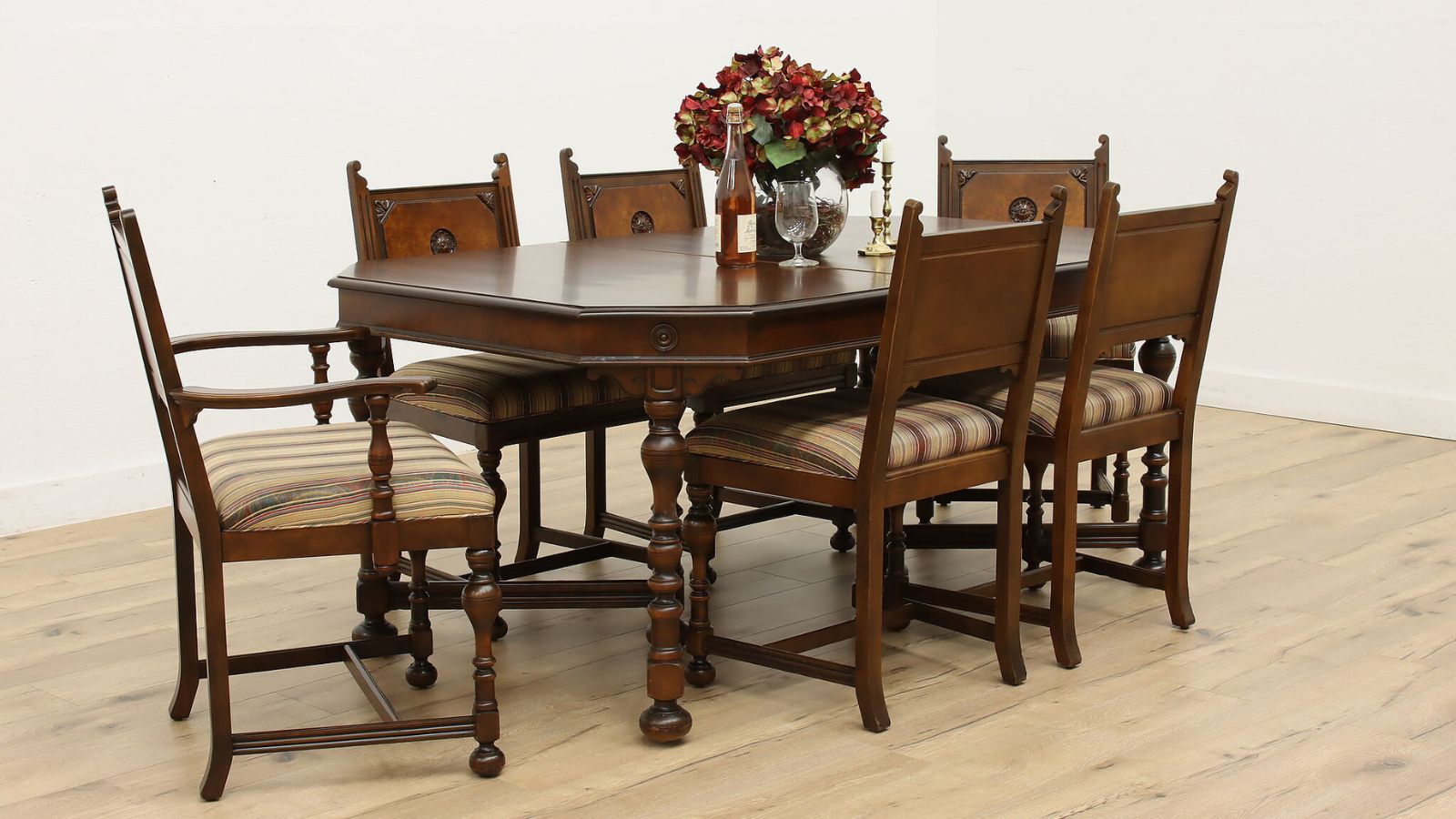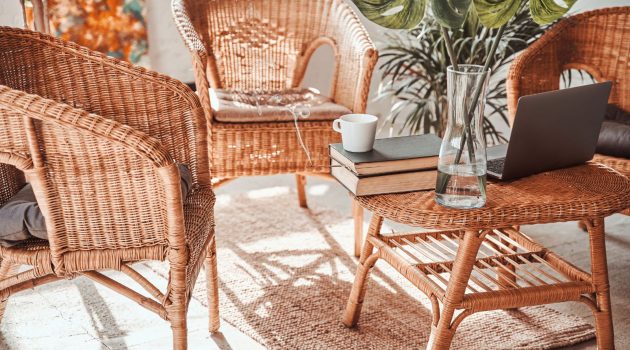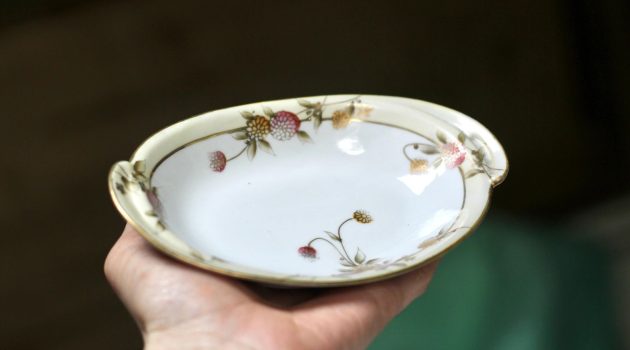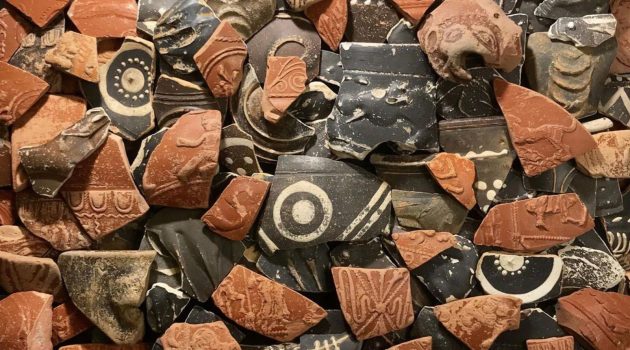Antique dining tables offer a window into the past, presenting not just a piece of furniture, but a testament to historic craftsmanship and evolving style.
Through their materials, designs, and construction, these tables tell stories of cultural and societal changes.
By learning to identify different styles of antique dining tables, you gain insight into the eras from which they originate and the hands that crafted them.
Recognizing various antique dining table types involves looking at their physical features, such as the shape of the legs, the patina of the wood, and the intricacies of their design.
Each table carries the hallmark of its period, whether it be the ornate carvings favored during the Victorian era or the clean lines of the Federal style.
To truly appreciate the value and heritage of an antique dining table, one must consider both its aesthetic contributions and its functional evolution over time.
Key Takeaways
- Understanding antique dining tables enriches your knowledge of history and style.
- Identifying tables involves examining their design, material, and workmanship.
- A table’s characteristics can reveal its age and the era it represents.
1. The Evolution of Dining Table Styles
Your journey through the history of antique dining tables will take you from the robust, communal tables of the medieval period to the elaborate designs of the Victorian era, and finally to the diverse styles of the early 20th century.
Medieval and Renaissance Inceptions
During the Medieval and Renaissance periods, dining tables were practical and sturdy, often made of heavy oak. You would commonly see long tables in great halls.
These tables were simple trestle types with removable tops, which were convenient for setting up and taking down during feasts.
Baroque to Neoclassical Advances
As you move into the Baroque period, the evolution of the dining table becomes more ornate. Mahogany started to replace oak and walnut, allowing for more delicate designs with ball and claw feet and intricate carvings.
By the time you reach the Neoclassical era, you’ll find that tables were often extendable, with refined designs inspired by the classical antiquity.
Noticeable among these styles are the Queen Anne and Chippendale styles, which had distinct leg shapes such as the cabriole leg, and sometimes incorporated pad or ball-and-claw feet.
Modern Antique Diversifications
The 19th and early 20th centuries witnessed further diversification in antique dining tables. Victorian tables boasted grandeur and opulence with rich details and substantive size.
In a subtler note, the Art Nouveau period introduced flowing lines and organic motifs.
As a collector, you might appreciate the sleeker lines of the Art Deco period that followed, with its geometric shapes and use of modern materials like metal and glass combined with fine woods.
As you explore antique dining tables, remember that their styles are windows into the past, each with a story to tell about the era it was crafted in and the hands that have dined at it.
2. Identifying Antique Table Types
Discovering the charm of antique tables involves understanding the different styles that have graced dining rooms over the centuries. Here, we’ll explore distinctive types that reflect their era’s craftsmanship and functionality.
Trestle and Refectory Tables
Trestle Tables: You’ll recognize these for their two or three vertical supports connected by a horizontal beam. Originating in the Middle Ages, trestle tables are one of the oldest dining table designs.
Typically, they were made to be disassembled easily, suiting the mobile lifestyle of the time.
Refectory Tables: Common in monasteries during the Renaissance, these tables share similarities with trestle tables but are often more substantial and permanent, featuring long, solid planks and heavy construction associated with a farmhouse table.
Gate-Leg and Drop-Leaf Designs
Gate-Leg Tables: Your antique search might turn up these ingeniously designed tables, identified by their framed legs that swing out like gates to support leaves, which unfold to expand the table’s surface.
- Butterfly Table: A variation of the gate-leg, the butterfly table is noted for its wing-shaped brackets that support the leaves.
Drop-Leaf Tables: These are the versatile ancestors of modern extendable tables, where the sides can be “dropped” down to save space when not fully in use. In compact form, they make for a convenient narrow console.
Pedestal and Console Varieties
Pedestal Tables: If you come across a table with a central column supporting the top, it is likely a pedestal table.
These were especially popular in the 18th and 19th centuries for their stability and elegant look, often found in round or oval shapes.
Console Tables: Although not typically used for dining, antique console tables were a fixture in dining rooms for displaying decor.
You’ll identify them by their half-moon shape and wall-mounted design, often with ornate carvings.
3. Materials and Craftsmanship
When exploring antique dining tables, you’ll notice that materials and craftsmanship offer a window into the era and origin of each piece.
From the woods chosen to the incorporation of metal and stone, these choices define the aesthetic and durability of the tables.
Wooden Masterpieces
Antique dining tables often showcase exquisite woodwork, with each type of wood bringing its unique grain, color, and characteristics.
Here’s a snapshot of common woods used:
- Oak: Known for its strength and heavy grain, oak was predominantly used in tables from the 17th century onwards.
- Mahogany: This reddish-brown wood has a fine grain and was a favorite for tables in the 18th century due to its durability.
- Walnut: Valued for its rich, dark tones and strength, walnut appeared in many 17th and 18th-century dining tables.
- Cherry: With its warm, reddish hue, cherry wood was often used for its workability and satiny finish.
These woods were shaped by skilled artisans who hand-carved intricate designs and joints, demonstrating remarkable craftsmanship without the use of modern tools.
Metal and Stone Accents
While wood is the primary material in antique dining tables, metal and stone feature as key accents, providing structural support and decorative elements.
Here’s a brief overview:
- Metal: Look for wrought iron, brass, or bronze detailing, especially in the table’s hardware like hinges, screws, and locks. These metals added both strength and a contrasting visual element.
- Stone: Especially marble, was sometimes used as a tabletop or inlay, adding a touch of luxury and easy-to-clean functionality.
Whether it’s an elegantly veined marble slab set within an oak frame or ornate brass fittings securing the corners of a walnut table, these materials complement the wood and enhance the table’s beauty and longevity.
4. Assessing Antique Dining Tables
When exploring antique dining tables, your focus should be on determining their age and rarity along with evaluating their condition and value.
These factors are crucial for understanding an antique piece’s place in history and its market worth.
Determining Age and Rarity
To ascertain the age of an antique dining table, you should first look for stylistic elements that align with specific historical periods. For example:
- Gate-leg Tables: Typically from the 17th century, recognized by their fold-down sides supported by hinged legs resembling gates.
- Butterfly Tables: Known for wing-shaped braces and possess characteristics from the 18th century.
Next, check for construction details, such as the types of joints used. Early tables often have hand-cut dovetail joints, indicating pre-19th-century craftsmanship.
Additionally, the type of wood can be a clue; mahogany suggests a table made after the mid-17th century when it became the preferred material.
Rarity is often linked to age, but also to how many pieces were produced and how many have survived. Tables from a well-known designer or limited production can be particularly rare.
Evaluating Condition and Value
Assess the table’s condition carefully:
- Surface: It should show signs of wear but not excessive damage.
- Stability: Check for wobbles or weak joints that may need repair.
Remember that unrestored tables can be more valuable as they have more of their original materials and workmanship. However, significant damage can also detract from the value.
When considering a purchase or sale, it is often beneficial to consult an antique appraiser who can provide a detailed valuation.
Finally, remember that value is about more than just money; historical significance and personal attachment can add immeasurable worth to your antique dining table.



